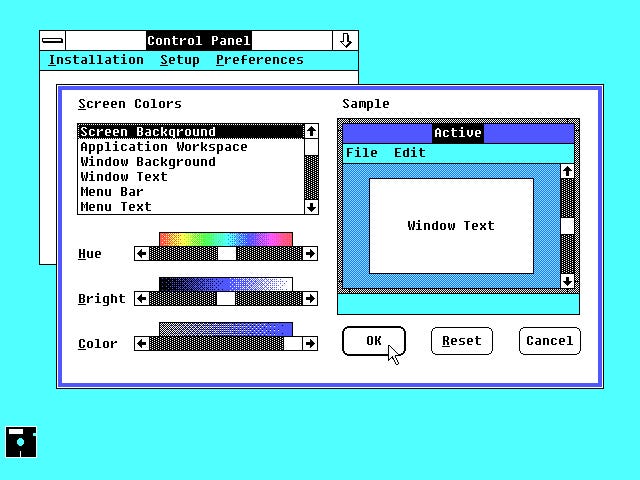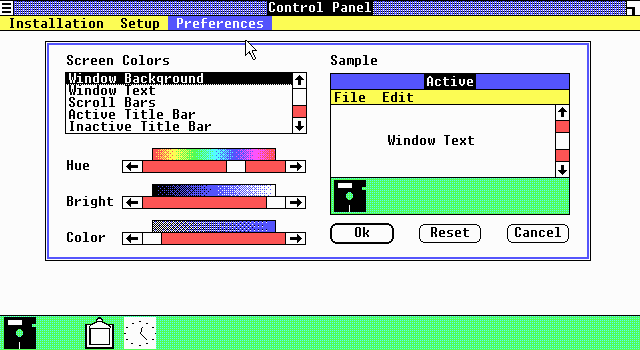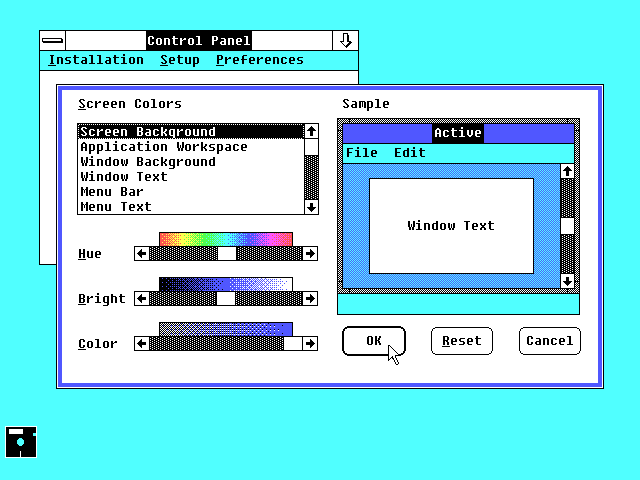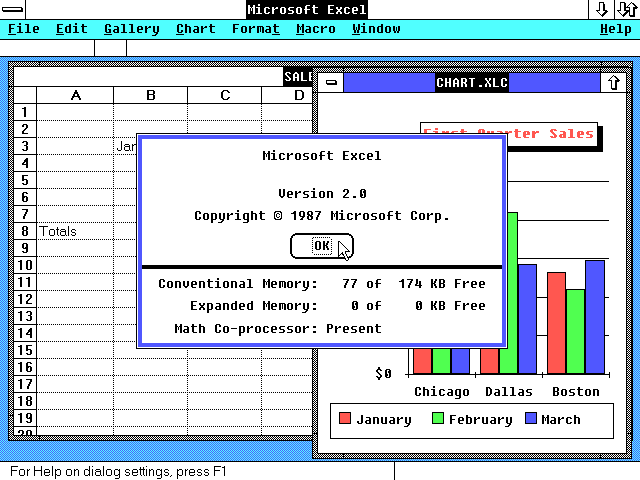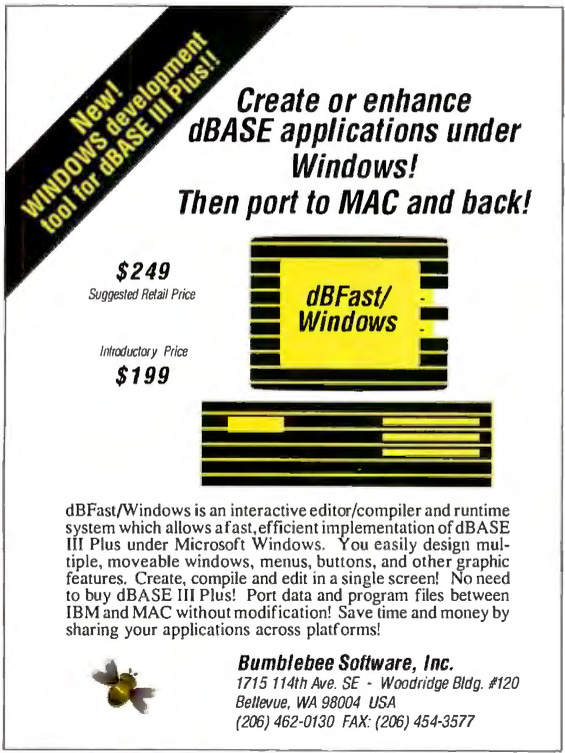After the release of Windows 1.0 on the 20th of November in 1985, Tandy Trower had precious little time to come up with a sequel. He had roughly 18 months to be slightly more precise. His first tasks were those features he’d wanted for Windows 1.0 but had little time to work on. Overlapping windows, a proportional system font, and more general UI improvements were all goals, and these were quickly achieved. Just looking at the Control Panel, these are immediately visible.
The first thing I notice here is that the aspect ratio is changed to 4:3 which tells us quite a bit about hardware support (specifically VGA support). There are more and better colors as well, and we see the windows are overlapping. Trower was, indeed, successful in making considerable UI improvements. The minimizing, maximizing, and overlapping windows bring the UI of Windows 2.0 closer to that of OS/2’s Presentation Manager, and this was purposeful. Microsoft and IBM were still intending OS/2 to be the future, and Ballmer intended Windows 2.0 to be the last version of Windows.
The team that had built Windows 1.0 had left for OS/2. This is just how big the OS/2 focus within Microsoft was. The new development manager for Windows 2.0 was formerly of the Applications Group. On the 20th of June in 1986, Microsoft completed the acquisition of Dynamical Systems Research for $1.5 million (around $4.2 million in 2023). This company had built Mondrian which was a competitor to IBM’s TopView and it had some compatibility with TopView. IBM had as a requirement for OS/2 just such compatibility. This acquisition was more important for Microsoft than for IBM in the long term. Several people from DSR would become leaders within Microsoft’s development teams.
The Windows team was working at odds with the overall mission of Microsoft, and yet they made massive strides. Adrian King, of the MS-DOS development team, used the code from the Windows 2.0 kernel and wrote a new memory management system that could take advantage of the Intel 80386 CPU’s expanded capabilities. This effort became Windows/386 which was effectively a port of Windows 2.0 to the 80386. While Windows 1.0 was limited to the PC’s 640k, Windows 2.0 could leverage EMS memory. This work expanded upon work done on this front by David Weise and Murray Sargent (if I understand this history correctly). On every other front, refinements and improvements were made to all of Windows 1.0’s features and technologies, new APIs were added, much of the system was rewritten in C from ASM, all while system requirements were only modestly increased: 8086 or 80386, 512k RAM, two double-sided floppy disk drives (or an HDD), Hercules, CGA, EGA or VGA graphics adapter, MS-DOS 3.0 or higher, pointing device heavily suggested. On the mouse front, Windows 2.0 included support for PS/2 mice.
Windows 2.0 missed its intended release of early 1987, but an alpha version was sent to developers and testers in early Summer of that year. Two beta releases followed in late Summer. Windows/386 was completed shortly before Windows 2.0 and this was shipped with the Compaq DeskPro 386 in September of 1987. Windows 2.0 and Windows/386 would see full market release on the 7th of December in 1987 with version 2.03.
Windows 2.03 was followed quickly by Windows 2.1 which came in two versions: Windows/286 and Windows/386. Both versions released on the 27th of May in 1988. The 286 version could work on an 8086/8088 but without HMA, and this version gained the support for LIM4.0 boards. The 386 version gained support for disk caching. For both versions of 2.1 a hard disk was now required, and for the 386 the memory requirement increased to 1MB. Version 2.1 also introduced support for the 8514/A display adapter as well as many bug fixes and memory management refinements. As with every release of Windows, general hardware support was increased.
By January of 1989, Windows was popular enough that numerous advertisements, reviews, and in-depth articles for or about 3rd party Windows 2x software, drivers, and development tools were popping up in trade magazines. Sales by this point were over 1 million copies.
On the 13th of March in 1989, Microsoft released Windows 2.11. This brought still better memory management, support for AppleTalk networks, better printer support, and more internationalization. By the end of 1989, Windows 2x had sold about 2 million copies.
Windows 2x had far more software made available for it than did Windows 1x, and Trower was successful at finally getting Microsoft to port their own software to Windows. As a result, Word and Excel were made for Windows!
Having a good word processor and a good spreadsheet on any software/hardware platform was absolutely vital in 1980s. Without these two types of application, your systems simply wouldn’t be competitive in the market place. Microsoft’s offerings were topnotch, and it is easy to imagine these two applications driving sales of Windows. It’s hard to say though as there was a multitude of software made for Windows 2x.
Tandy Trower was hyper aware of Ballmer’s intent to have 2x be the end of Windows, and he felt that once again he’d need to find a new job. He felt that Microsoft needed to improve their applications’ visual design and defined a group to do just that. This team would employ graphic designers (as opposed to developers) to do visuals, establish usability and testing services and facilities, define a visual design standard for uniform look/feel, and project visual design for the future. He took this proposal to Bill Gates, and Gates agreed. Trower transferred over the Applications Group under Mike Maples.
Microsoft and Apple have a very long history, and Microsoft had been developing software for the Macintosh since its debut. For example, while Windows users had to wait for Excel, Macintosh users had Excel in 1985. Microsoft also wrote the replacement for Integer BASIC for the Apple ][ line. This relationship didn’t stop Apple from attempting a lawsuit against Microsoft for Windows’ design.
Gates had very quickly realized the power of graphical interfaces, and he had suggested to John Sculley and Jean Louis Gassee that Apple license its GUI. From an email on the 25th of June in 1985:
As the independent investment in a “standard” architecture grows, so does the momentum for that architecture. The industry has reached the point where it is now impossible for Apple to create a standard out of their innovative technology without support from, and the resulting credibility of other personal computer manufacturers. Thus, Apple must open the Macintosh architecture to have the independent support required to gain momentum and establish a standard.
Sculley was prepared to go through with licensing and had some wheels in motion toward this end, but Gassee rejected the plan. He felt that licensing would cannibalize the sales of the Macintosh line. Additionally, Macintosh sales were slowing. Gassee didn’t view Windows 1x as a threat, but Sculley did. Jack Brown (one of Apple’s lawyers) went to Microsoft’s headquarters to speak with Gates and threatened legal action against Microsoft. Gates was… less than thrilled.
Microsoft was paying license fees to Xerox for GUI elements that were similar to those on the Alto (Xerox 8010) just as Apple was. Microsoft had started development of their graphical systems before the Apple Macintosh was made available to them. From the perspective of Microsoft, no wrong had been committed. Yet, Apple was a huge company in comparison to Microsoft at this point in time. It is reasonable to assume that Apple felt very secure.
In response to Apple’s legal threats, Gates called Sculley and threatened to cease all Macintosh software development at Microsoft. This would have hurt both companies rather seriously. In the end the two signed a contract allowing Microsoft to continue developing and selling Windows via a license for Macintosh visual designs, and to continue making and selling Macintosh application software on the 22nd of November in 1985.
Apparently, this didn’t matter. Seeing Windows 2x, Apple filed suit against Microsoft on the 17th of March in 1988 for violating Apple’s copyrights on 189 different visual displays within Windows 2. Ultimately, the court ruled in favor in Microsoft on the 25th of July in 1989. Specifically the ruling stated that 179 of 189 displays in dispute were covered by the license already granted and further that the remaining 10 could not be copyrighted. The suit was finally decided in Microsoft’s favor on the 24th of August in 1993 after many appeals which included the Supreme Court declining to hear the case.
On the part of Trower, the Macintosh hadn’t factored at all. According to him, the similarities between Windows 2 and the Macintosh stem from Xerox. Both companies had dealings with Xerox, and both CEOs introduced their companies to Xerox technologies. Trower even stated:
To me, the allegation was almost insulting. If I wanted to copy the Macintosh, I could have done a much better job.
Despite all of the litigation, Windows 2 made it to market, gained 3rd party support, and signaled a massive transition in computing that all of the competition had failed to do. With Windows 2, millions of people were using a graphical desktop with graphical applications. The mouse was made a standard tool. PCs were now being urged to adopt powerful graphics adapters. Many people claim Windows 2 to be a failure, but this is not an accurate assessment. While it didn’t sell to the level of later releases, the market hadn’t really become accustomed to buying an operating system on a store shelf. People typically received an OS as part of a computer purchase. That Microsoft was able to sell over 2 million copies of Windows 2 shows a serious change; MS-DOS’s days were now numbered.



